When you consider motorcycle performance, the power-to-weight ratio is a vital element you can't overlook. It directly impacts how quickly a bike accelerates and how well it handles in various conditions. If you're aiming for a ride that feels responsive and agile, understanding this ratio can guide your choices. But how do different manufacturers, like Ducati, approach this balance? And what can you learn from their engineering philosophies? The answers might surprise you as you explore the nuances of performance dynamics.
Key Takeaways
- The power-to-weight ratio indicates the balance between engine power and motorcycle weight, impacting acceleration and handling.
- Higher power-to-weight ratios enhance maneuverability, control, and braking performance, improving the overall riding experience.
- Ducati's innovative engineering emphasizes lightweight materials and aerodynamics, resulting in superior power-to-weight ratios compared to competitors.
- Regular maintenance and proper tire selection are crucial for optimizing motorcycle performance and maintaining an ideal power-to-weight ratio.
Understanding Power-to-Weight Ratio
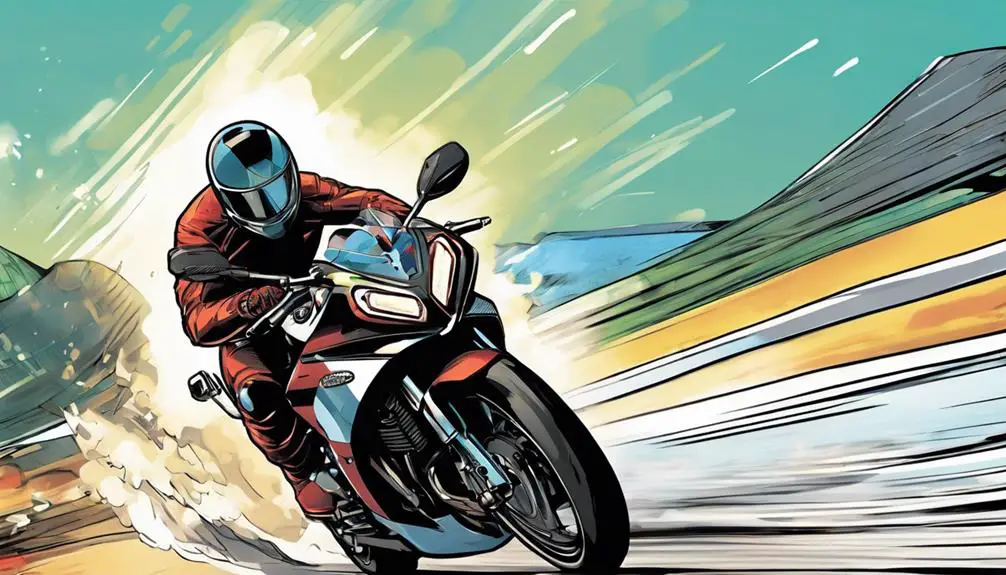
The power-to-weight ratio is a key factor that determines a motorcycle's performance and agility on the road. It's the relationship between the motorcycle's engine power and its weight, expressed as horsepower per pound or kilogram. You want a high power-to-weight ratio because it means your bike accelerates faster, handles better, and responds more readily to your commands. When you twist the throttle, you feel that exhilarating rush as your machine effortlessly surges forward.
Understanding this ratio is essential for anyone seeking the freedom of the open road. A lighter bike with a powerful engine gives you a sense of liberation, allowing you to navigate twists and turns with ease. You'll find that every ride becomes an adventure when your motorcycle can swiftly respond to your every whim.
Conversely, a heavier bike can feel sluggish and cumbersome, limiting your ability to explore the world freely. By grasping the importance of power-to-weight ratios, you can make informed decisions about which motorcycle suits your spirit of adventure, ensuring that your ride embodies the thrill and excitement you crave.
Embrace this knowledge, and let it guide you toward the ultimate riding experience.
Importance in Motorcycle Performance
Understanding the importance of power-to-weight ratios boosts your motorcycle's performance, making every ride more exhilarating and responsive. When you grasp how this ratio affects acceleration and handling, you reveal the true potential of your machine. A higher power-to-weight ratio means your bike can accelerate faster, allowing you to feel the rush of liberation as you conquer the open road.
Imagine leaning into a turn, feeling the bike respond instantly to your commands. With a favorable power-to-weight ratio, you're not just riding; you're dancing with the asphalt. It enhances your control, enabling you to navigate twists and turns with confidence. Whether you're cruising down a highway or tearing through backroads, that extra power translates to freedom.
Moreover, a well-balanced power-to-weight ratio improves braking performance. You'll notice it takes less effort to slow down or stop, giving you peace of mind as you ride. This balance between weight and power cultivates a connection between you and your bike, fostering a thrilling experience every time you hit the throttle.
Embrace this knowledge and let your motorcycle elevate your sense of adventure and freedom.
Ducati's Engineering Philosophy
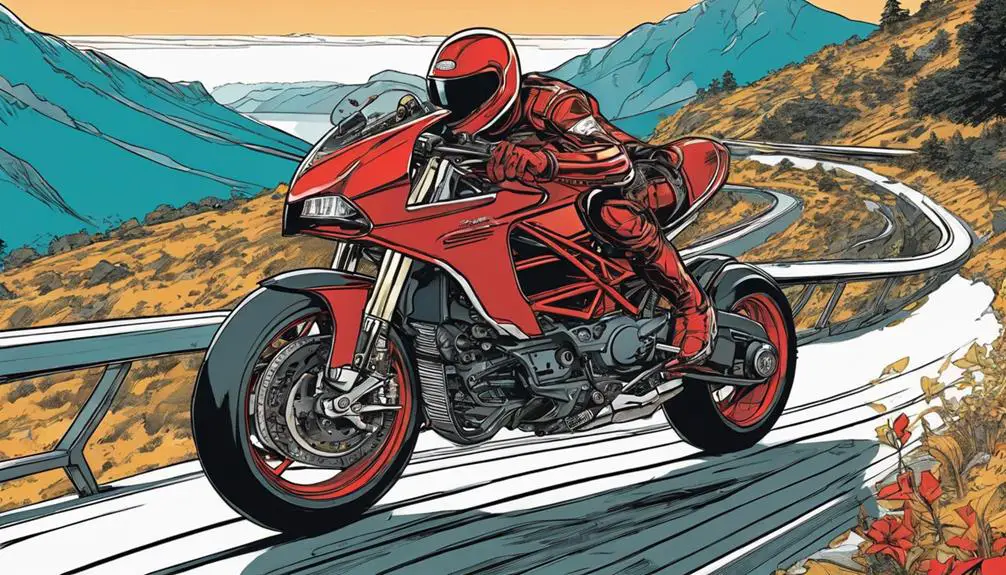
Ducati's engineering philosophy centers on creating powerful yet lightweight machines that deliver an exhilarating riding experience.
You'll find that this approach isn't just about raw power; it's about the harmony of performance and agility. When you ride a Ducati, you're not just controlling a motorcycle; you're embracing freedom.
Every component is meticulously designed to enhance the power-to-weight ratio, ensuring that each bike feels alive beneath you. From the moment you twist the throttle, you'll appreciate how swiftly your machine responds.
Ducati engineers focus on using advanced materials like aluminum and carbon fiber, stripping away excess weight while maintaining strength. This isn't just engineering; it's a commitment to your liberation on the road.
With an emphasis on aerodynamics and balance, Ducati bikes aren't just fast; they're exhilaratingly nimble. You'll feel the connection between man and machine, where every curve, every twist of the road, becomes an invitation to push limits.
Ducati's philosophy isn't merely about performance; it's about the joy of riding with a sense of freedom that's uniquely yours. So, when you ride, you're part of a legacy that celebrates the spirit of adventure.
Historical Overview of Ducati
Since its inception in 1926, Ducati has consistently evolved, blending innovation with a rich heritage to become a symbol of performance and passion in the motorcycle world. You can trace its journey through several pivotal moments that shaped its identity. The brand's commitment to speed and agility has always attracted those who crave freedom on two wheels.
- 1926: Ducati starts as a radio company, but soon pivots to motorcycle production.
- 1950s: The introduction of the Ducati 125, marking the brand's entry into racing.
- 1970s: The revolutionary Desmodromic valve system showcases Ducati's engineering prowess.
Each of these milestones reflects Ducati's relentless pursuit of excellence.
As you dive deeper into Ducati's legacy, you'll find that it's not just about machines; it's about the spirit of adventure and the thrill of the ride.
Embrace the passion that Ducati embodies and let it inspire your own journey in the world of motorcycling.
Key Ducati Models Analyzed
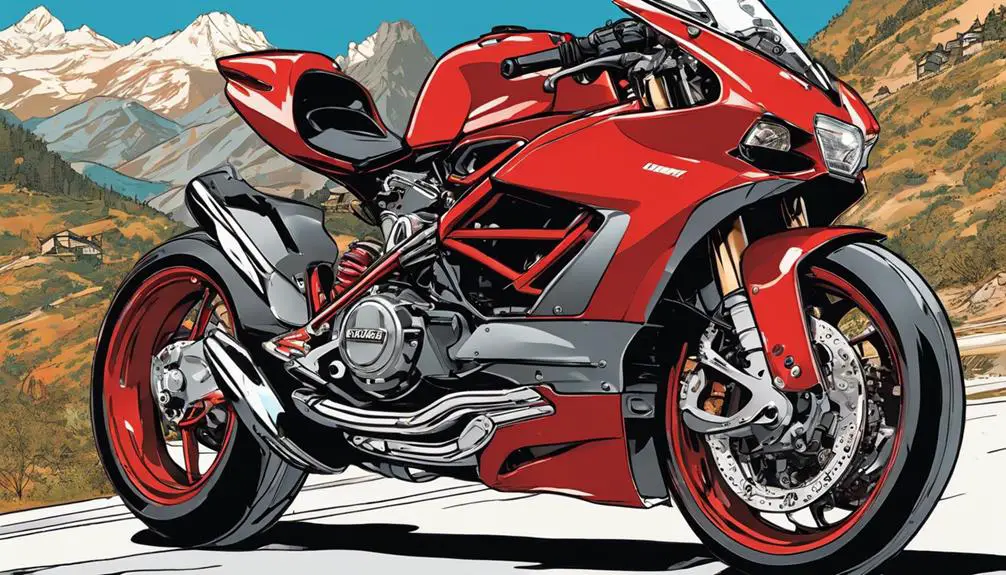
Diving into key Ducati models reveals a fascinating blend of engineering excellence and thrilling performance that defines the brand's legacy. You'll find that each model offers a unique experience, capturing the essence of freedom that every rider craves.
Take the Ducati Panigale V4, for instance. Its aggressive design and aerodynamic lines not only turn heads but also enhance stability at high speeds, giving you the confidence to conquer any road.
Then there's the Ducati Monster, a streetfighter that embodies raw power. Its lightweight frame and naked styling encourage you to explore urban landscapes with an exhilarating sense of liberation.
The Multistrada, on the other hand, is your gateway to adventure. With its versatility and comfort, it invites you to roam beyond the beaten path, embracing the thrill of discovery.
Lastly, don't overlook the Scrambler series, which fuses retro charm with modern performance. This model celebrates individuality and invites you to express your unique riding style.
Each of these Ducatis resonates with a passion for riding, urging you to break free from the ordinary and embrace the extraordinary journey that awaits.
Power Output and Weight Specs
When evaluating the power output and weight specs of various motorcycle models, you'll find that these figures play an important role in determining their overall performance and handling characteristics.
The balance between horsepower and weight can release the freedom you crave on the open road. A lighter bike with a powerful engine often results in quicker acceleration and more responsive handling, allowing you to make the most of every ride.
Consider these key points:
- Horsepower: More power means better acceleration and speed, letting you feel the thrill of the ride.
- Weight: A lighter bike is often easier to maneuver, enhancing your control and confidence as you navigate turns.
- Power-to-Weight Ratio: This significant metric helps you gauge a motorcycle's performance; the higher the ratio, the more exhilarating the ride.
Comparing Ducati to Competitors
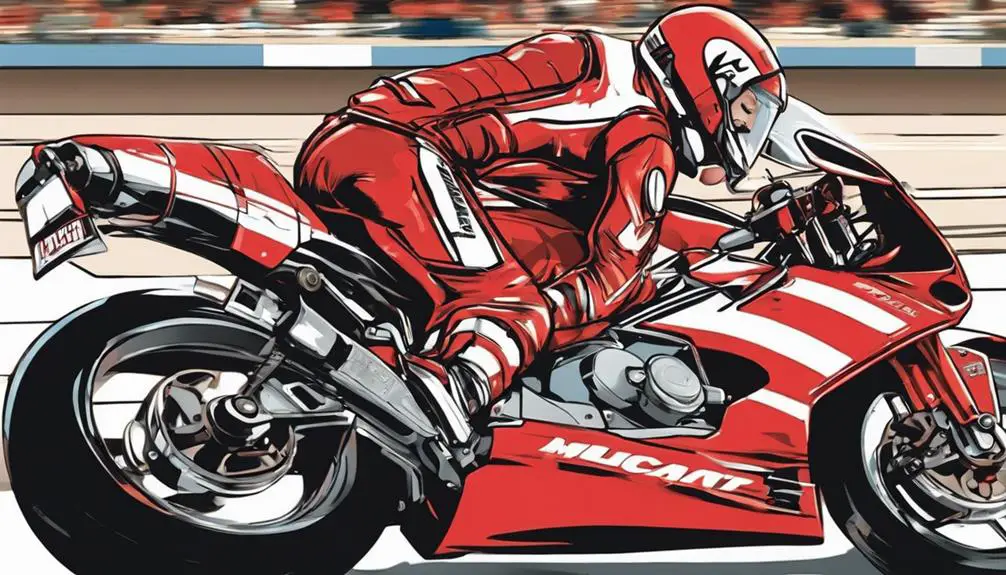
In comparing Ducati to its competitors, you'll notice how their innovative designs and engineering choices greatly impact power-to-weight ratios and overall performance. Ducati's commitment to lightweight materials and advanced aerodynamics sets them apart from other brands. While others may prioritize raw horsepower, Ducati understands that balance is key—power should flow seamlessly with control.
Take the Panigale series, for example. Its meticulous engineering guarantees that every ounce of weight is minimized, allowing you to experience the thrill of acceleration without feeling weighed down. When you hop on, you'll immediately sense the difference—Ducati bikes feel alive, ready to respond to your every command.
Now, look at competitors like Yamaha or Kawasaki. While they deliver impressive power, their heavier frames can make a ride feel cumbersome. This isn't just about speed; it's about liberation on the road. You want a bike that feels like an extension of yourself, not a burden.
When you compare the power-to-weight ratios, Ducati often leads the pack, giving you the freedom to carve through corners and release your spirit. In the world of motorcycles, it's not just about the ride; it's about how that ride makes you feel.
Common Issues Affecting Performance
Even with Ducati's impressive power-to-weight ratios, several common issues can impact overall motorcycle performance and your riding experience. You might feel the thrill of the ride, but these factors can hold you back from reaching your full potential.
- Tire Quality: Worn or inappropriate tires can reduce grip and stability, affecting your handling and safety.
- Fuel Quality: Poor-quality fuel can lead to knocking and reduced engine performance, hindering your acceleration and responsiveness.
- Regular Maintenance: Neglecting routine maintenance, like oil changes and chain adjustments, can lead to decreased performance and potential breakdowns.
Future of Ducati Innovations
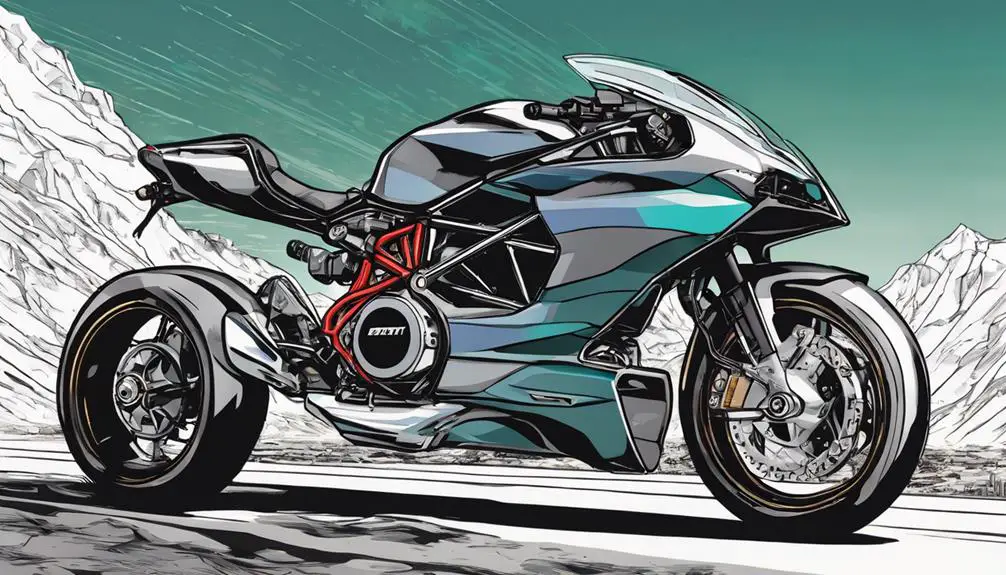
Ducati's commitment to cutting-edge technology and performance enhancements positions them at the forefront of motorcycle innovations, ensuring an exhilarating riding experience for enthusiasts.
As you look ahead, expect Ducati to reveal advancements in lightweight materials and electric propulsion that redefine power-to-weight ratios. Imagine riding a bike that offers the raw thrill of speed while being kinder to the environment.
With their focus on aerodynamics, you can anticipate designs that slice through the air, enhancing both performance and efficiency. Advanced electronics like adaptive suspension and smart traction control will give you the freedom to conquer any terrain, adapting to your riding style in real-time.
Ducati's future innovations will also likely embrace connectivity, allowing you to integrate your ride with smart devices seamlessly. Picture customizing your bike's performance parameters with a simple tap on your phone, creating the ultimate personalized experience.
As Ducati pushes the boundaries, you'll find yourself liberated in a world where technology amplifies your passion for riding. The future is bright, and it promises to be exhilarating—where every twist of the throttle takes you closer to the freedom you crave.
Frequently Asked Questions
How Does Riding Style Affect Motorcycle Power-To-Weight Ratio?
Your riding style can greatly influence how you experience your motorcycle's performance.
If you lean into curves and maintain a smooth throttle, you'll harness the bike's power effectively.
However, aggressive acceleration or sudden braking can disrupt balance, making it harder to control.
What Tools Can Help Measure a Motorcycle's Power-To-Weight Ratio?
To measure your motorcycle's power-to-weight ratio, you can use a few handy tools.
A dynamometer will give you precise horsepower readings, while a scale helps you weigh your bike.
Some riders also use smartphone apps designed for motorcycle performance tracking, making it easy to calculate ratios on the go.
With these tools, you'll gain insights that can enhance your riding experience and release your bike's true potential!
Are There Regulations Regarding Power-To-Weight Ratios in Racing?
Imagine a soaring eagle, unbound and free, cutting through the sky.
In racing, regulations on power-to-weight ratios exist to guarantee fair competition and safety. Each racing body sets specific limits, often based on vehicle class and type.
These rules help maintain a level playing field, so every rider can experience the thrill of the race without the risk of overwhelming power.
How Can Weight Distribution Impact Performance Despite Power-To-Weight Ratio?
Weight distribution plays a vital role in your vehicle's handling and overall performance.
If you shift weight too far forward or backward, you might struggle with cornering or acceleration. Properly balancing the weight allows you to maintain traction and control, enhancing your ride's stability.
So, even if your power-to-weight ratio looks great on paper, poor weight distribution can limit your true potential on the road.
It's all about finding that sweet spot for liberation in performance!
What Modifications Can Improve a Motorcycle's Power-To-Weight Ratio?
To boost your motorcycle's power-to-weight ratio, consider lightweight components like carbon fiber wheels or an aluminum frame.
Upgrading your exhaust system can enhance engine performance by reducing weight and improving airflow.
You might also tune your engine for more horsepower, while removing unnecessary accessories can shed extra pounds.
Finally, maintaining ideal tire pressure guarantees better handling and performance.
These modifications help you feel the freedom of the open road even more!
Conclusion
In the world of motorcycles, the power-to-weight ratio is like a dance between horse and rider; when they're in sync, the ride becomes exhilarating.
Just imagine launching out of a tight corner, feeling the surge of power as the bike effortlessly accelerates beneath you.
Ducati embodies this harmony, crafting machines that merge strength and agility.
As you explore your options, remember that the right balance can transform your journey into an unforgettable adventure on the open road.